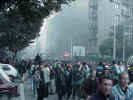|

of the Belgrade Coup
Editor & Webmaster
Leon Chame - 2008
Yugoslav Associates:
- Zoran Radojicic
- Dejan Vukelic
- George Orwell
Contributing Websites:
- Original Sorces
- Transnational (TFF)
- Fair sources
- WSWS
avgust 20, 2008
| |
9. Strikes to Deliberately Create Hardship and Unemployment.
IT GOES WITHOUT saying that if the international reporting on the
Kosovo conflict was correct then certain "facts on the ground" would be very
different from what they have really proven to be. It had been stated that NATO
forces had, by mid-April 1999, destroyed the Yugoslav Armed Forces’ capability to
wage war.
The problem began with the original premise of the US Clinton
Administration that the Yugoslav Government of Slobodan Miloševic would fall into
disarray and compliance once the White House committed US and NATO military forces into
combat against Yugoslavia.
US analysts are known to have told the White House that once air
strikes began against Yugoslavia, as they did on March 24, 1999, then refugees in massive numbers would begin to flee from Kosovo into
neighboring countries. There were, before the air strikes
began, no refugees in the Former Yugoslav Republic of Macedonia, and only a few (those
connected with the UCK) in the anarchic northern areas of Albania. There is no question but that the White House had been told unequivocally
by its own intelligence services that a massive refugee flight from Kosovo would begin
with the bombing. The White House chose to ignore this advice.
This writer returned to Yugoslavia to compare the media coverage with the facts on the
ground. This particular passage was written, on April 19, 1999, at 22.35hrs, as air raid
sirens were wailing throughout Belgrade. What was discovered
"on the ground" was a very different reality to that being promoted by the US
and UK administrations.
Civilian Targets:
Despite claiming victory for the destruction of Yugoslavia’s oil refining
capability, the US and NATO failed to disclose the reality of their air strikes. This
writer saw the results of some of the strikes. In the city of Pancevo, virtually a suburb
of Belgrade, air strikes had repeatedly hit the oil refinery, the fertilizer factory and
the petrochemical plant — all among the largest installations of their type in
South-Eastern Europe — and an aircraft manufacturing facility. The damage was indeed
enormous, but, despite repeated claims that only military-related
targets were being hit, it was clear that at Pancevo, and at many other locations in
Yugoslavia, strictly and unequivocally civil targets were being struck. This, given the precision of the targeting, indicated that the conduct
of the war and its objectives were very different than those being cited by the White
House.
By April 19, 1999, a conservative estimate concluded that 400,000 to 500,000 Yugoslavs
(not counting the Kosovo refugees) out of the appr. 11-million population had directly lost their employment because of the destruction of their
factories. This meant that some two-million people were without income. But
indirectly, the impact on employment was far greater. When the 300,000 car-a-year
automobile factory — the one which made the Yugo car — was destroyed, for
example, all of the component makers were themselves "hit": they lost their
customer, forcing their own closure or cutbacks.
At Pancevo alone, some 10,000 people were thrown out of work, and the city began to
empty as children were sent to stay with relatives in the country, and those rendered
jobless took their families in search of safety.
The air strikes against the oil refinery may have been understandable, given that a
legitimate military or strategic target is indeed the fuel supply which services the Armed
Forces. But it was struck, on one of the attacks, on the first
day of the Orthodox Easter, a pointed reminder that the
Clinton White House — which had hesitated to launch strikes against Iraq during the
Muslim Ramadan holy period of fasting — cared little
for the sentiments of the Orthodox communities worldwide. This did not pass unnoticed
among the 300-million Orthodox Christians around the world.
The total value of the damage in Pancevo was about $1.3-billion, some $650- million of
this at the oil refinery, which was hit a total of three times (by April 19, 1999). [Total
cost of the war to the Yugo-slav infrastructure during the first 30 days of bombing is
estimated at $100-billion.] The flames at the Pancevo oil refinery, soaring 20 meters into
the air, and billowing black smoke continued unabated two days after the last of the
strikes. The nearby HIP Petrochemija petro-chemical plant was also
severely hit, and the careful strikes were not an
accidental spillover from the hits on the oil
refinery.
Several facts are important with this. There was clearly no
strategic or military value to the HIP plant; it was purely a strike to deliberately
create hardship and unemployment. This target, and scores
(perhaps hundreds) of other air strikes at civilian targets throughout Yugoslavia, demonstrates clearly that the strategic objective presumably dictated by
the Clinton White House is the punishment of the Yugoslav population, not (as is stated repeatedly) the "destruction of
Miloševic’s military machine".
This directly contradicts US Secretary of State Madeline
Albright’s statements to the Yugoslav people, in Serbo-Croat, that she
"loves" the Serbian people and does not wish to punish them for the alleged
misdeeds of their Federal President. Regardless of
President Clinton’s motives, Secretary Albright clearly harbors enormous animus
toward the Serbian people, although those who knew her in Belgrade before and after
World War II can recall no incident which might have colored her
judgment of Yugoslavia.
But specifically the strike against HIP Petrochemija highlighted the gratuitous
campaign against the civil population, rather than military targets. HIP manufactures
chlorine for use in PVC. Had chlorine stockpiles been hit, then
Pancevo would have lost its entire population to the toxic outflow into the atmosphere.
HIP executives, working with town officials, feared air strike damage when the attacks
began and worked feverishly to process and move the chlorine. Moving it untreated would
have been difficult and would have merely led to further problems. Luckily, at the last
minute, the facility was largely emptied of chlorine when the strikes occurred.
On March 24, 1999, however, a Romanian train was at Pancevo railway yard when air
strikes began hitting targets less than a kilometer away. About 800
tonnes of chlorine was aboard the train. Had it been hit, most of Belgrade’s
population would have been killed by the toxic out-flow. As it was, the levels of
toxicity in the atmosphere after the waves of strikes in Pancevo were many times higher
than the safe level. Not all of the toxins came from the oil refinery or the petrochemical
plant.
A major fertilizer plant, not far from the refinery and the HIP
plant, was also hit: another clear civil target. Here,
had the plant’s liquid ammonia stockpiles been hit, the environmental damage would
have been enormous, as in the case of the chlorine. As it was, there
was sufficient chlorine and liquid ammonia, coupled with the petroleum which was hit,
to create the high toxicity levels in the city and to produce an
enormous, lingering cloud which was moving toward Belgrade. The wind shifted and
much of the cloud dissipated into the upper atmosphere to flow over other parts of Europe.
The fertilizer plant was hit on Western Easter, April 4, killing several workers and
injuring dozens more. Ironically, this day was as sacred to the city as Orthodox Easter: a
large Slovak and Hungarian population lived near the facility and worked in it. The
Reformist and Evangeli-cal Christians from these two communities spent their Easter in
mourning. City officials and civilians we spoke with in Pancevo
said that they believed that the US targeting of their town’s highly-volatile
products was evidence of a US policy of genocide toward the Serbs. Why else would they
risk such "collateral damage" which could have cost literally millions of lives
in the greater Belgrade metro area?
Pancevo was not left alone with the destruction of these three facilities. An air-craft
manufacturing facility, Utva Lola Corporation (a joint State/worker owned company like the
petrochemical and fertilizer plants) on the edge of the city was completely destroyed by
repeated Cruise Missile attacks, starting early in the air war. The facility produced only
agricultural aircraft at this stage, although during the previous era — under the
now-defunct Socialist Federal Republic of Yugoslavia (SFRY) — it produced the Arao
indigenous fighter aircraft, an example of which still sits as a monument at the
factory gates. This facility, at a stretch, could be considered at least a potential
military target. Certainly it could have serviced military aircraft. The factory was hit
four times, with damage estimated at $450-million [the capital investment in the plant,
high for a facility to make agricultural aircraft, reflected its military aircraft
origins]. In the process, some 100 homes were hit, many destroyed. We saw the damaged
houses, and the tractor-towed carts of families moving out of the town and into the
hoped-for safety of the countryside.
The general impression is that this is an area populated by some
26 ethnic groups, only one of which —the Kosovo
Albanians — has some members which refuse to call themselves "Yugoslav".
The Pancevo area is no different: it is home to some 20 ethnic groups. The spires of
the churches of a half-dozen different Christian sects dot the city.
By April 19, 1999, it was estimated by Yugoslav authorities that
some 1,000 of their citizens had been killed by the bombing and some 6,000 more wounded.
Given the extent of the damage seen by this writer, the claims are not difficult to
believe.
Some 200 schools had been hit to at least some degree, and
schools with about 800,000 students were closed because of the war, and had been since
March 24. No one wants to risk a full strike on a school filled with children.
A pipeline on one of the five destroyed Danube bridges carried
water to some 600,000 people.
The heating plant in Novi (New) Belgrade was destroyed, cutting
off steam heating to about half of Belgrade. A few months earlier, such an attack
would have led to widespread death and suffering in the bitter Balkan winter.
These things we saw.
10.The Refugee Burden Inside Serbia
|


